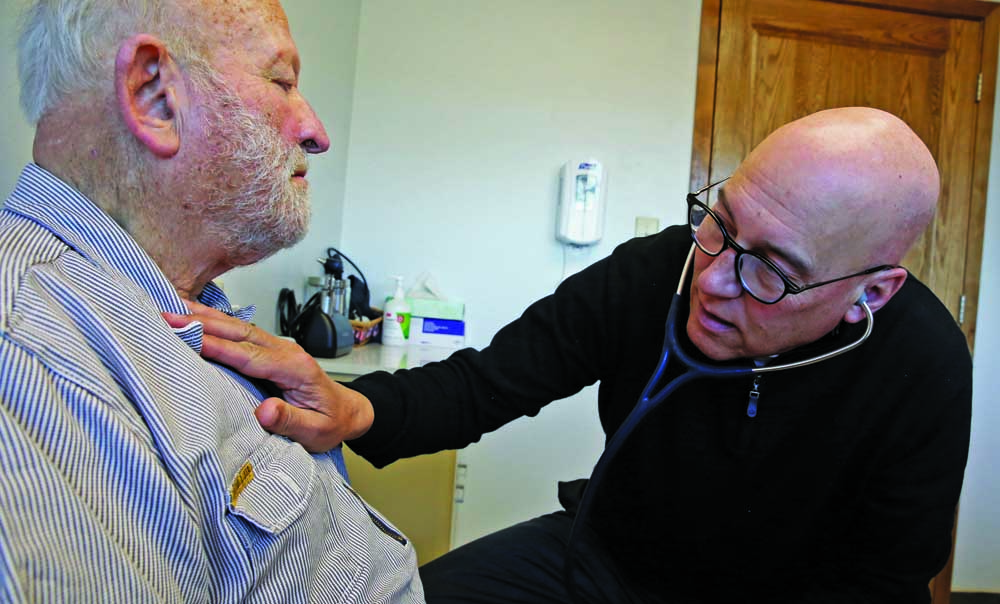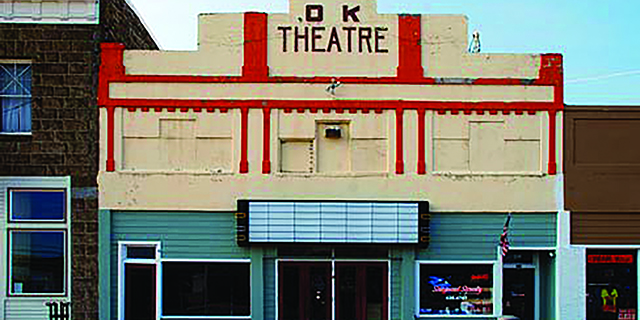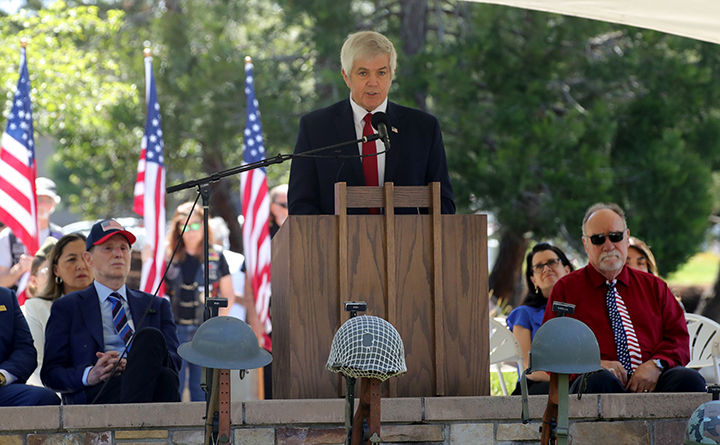St. Charles cardiologist answers the call for doctors in rural areas
Published 5:00 am Friday, March 20, 2020

- Dr. Bruce McLellan listens to John Conley's heart at the Blue Mountain Hospital District Annex in John Day. (Dean Guernsey/Bulletin photo)
Like he listens to the rhythm of a heart, Dr. Bruce McLellan concentrates on the engine clicks in his Cessna P210 to identify any irregularities.
The St. Charles Health System doctor revs his plane’s engine as it sits on the tarmac. When he’s confident the plane is ready for flight, he lifts off from Bend Municipal Airport and heads east under cloudy skies. As he ascends, he scans the horizon for bad weather to ensure the flight from Bend to John Day will be uneventful.
Lives depend on his precision. He has patients to treat. He’s the only cardiologist within 150 miles of the small rural town.
The 42-minute flight is unremarkable, a product of practice: McLellan makes this trip twice per month to visit cardiac patients in John Day who would otherwise face hours of driving to see a specialist like him. So far, he’s logged 720 hours in the air since he began flying to John Day in 2004.
“It’s a commitment to rural medicine,” says 63-year-old McLellan. “Flying saves me a lot of time, and that means I can see more patients.”
In John Day, at a tiny clinic on Ford Road run by Blue Mountain Hospital, McLellan sets up his laptop using a Wi-Fi hotspot to send and receive patient records. Meanwhile, his patients for this morning are filling the clinic’s waiting room. They arrive early; some have driven an hour to get to see him. They chat among themselves.
The receptionist at the rural clinic for visiting doctors walks outside to hang a sign with McLellan’s name, but it’s misspelled. McLellan says it doesn’t matter that they added a C to his name. What matters is the medicine.
“I’m the only cardiologist that comes out here,” McLellan said. “There’s a podiatrist that comes here, a neurologist and a urologist.
“When I come here, there’s no paperwork. I just come here to see patients. It’s pure medicine.”
Specialty medicine
With more than a third of Oregon living in communities more than 10 miles from towns of 40,000 or more people, access to specialists is limited, according to the Oregon Rural and Frontier Health Facility listening tour report. Rural communities have higher death rates than urban communities, according to the same study.
That’s why specialized care in rural and frontier communities is vital.
McLellan goes to see patients who have had cardiac catheterizations or may have been referred by their general practitioner. In between patients, he’s checking the weather for the flight back to Bend. Once a month, a technician comes with him to do echocardiograms. When he travels, he flies with a certified medical assistant to write up medical orders.
In McLellan’s medical group, 14 doctors with other specialties cover rural Oregon, driving to Sisters, Redmond, Madras, Prineville, Burns, Lakeview and La Pine, McLellan says. He volunteered to take John Day because of the distance and because he could fly his plane.
“It’s from our commitment to rural medicine that drives doctors to go to Lakeview and Burns,” he said.
The medicine is old-school stethoscopes and listening to patients talk about their medical histories.
“It’s pure medicine,” McLellan says. “In its essence, it’s the patient and their family. That’s what we do in spades. It’s like a little escape, a slower pace.”
John Day patients can get their echocardiograms done in their own community because McLellan comes to town. They don’t have to wait until they require an emergency helicopter flight to Bend or Boise for treatment.
Heart disease is the second leading cause of death in Oregon with higher mortality rates in rural and frontier Oregon compared to urban areas, according to the Oregon Office of Rural Health, which released a 2016 report highlighting the current rural medicine situation.
“It really makes a huge difference in the community to have access to specialists,” says Ashley Carey, a certified medical assistant at the clinic. “I grew up here. The community comes together to help each other.”
John Conley, a retired plastic surgeon, came to see McLellan for a pacemaker checkup. He and his significant other drove 30 minutes from their home, grateful that they didn’t have to make the three-hour drive to the Bend-Redmond area.
“I don’t know how we could have done this without having the doctor here,” Conley says. “Getting a good doctor is an issue especially in the country. More doctors should come out to the country.”
The only downside, Conley says, is that he has to make his appointments weeks in advance. More patients could be seen by specialists with the use of telemedicine, but doctors like McLellan would prefer to rely on his ability to touch his patients, the ability to interact with the patient and his or her family and needs a strong internet to upload pacemaker information.
“As long as we have choices as doctors to see patients, I’d like to continue to come out here,” McLellan says. “I know it helps. Even if you did this once a month, every specialist, you’d raise the quality of care.”
Seated in an examination room, Susan Kyriss, a 61-year-old Mt. Vernon resident, said if McLellan didn’t come to John Day, she’d have to find a friend to drive her to Bend to be examined by a cardiologist for her leaky heart valve.
“He knows what he’s talking about. Dr. McLellan is so soft-spoken and patient,” Kyriss says. “He takes his time.”
Rural primary care doctoring
It takes a special person to be a doctor in rural Oregon. Primary care doctors in places like John Day are expected to be skilled in a wide array of treatments: deliver babies, freeze skin lesions and even staff the emergency room.
“They have training and confidence to provide a broad spectrum practice,” said Dr. Jeff Absalon, St. Charles Health System chief physician executive. “It can be difficult to recruit people who do these things. But it can be a lot of fun too.”
To recruit doctors to stay or train in these rural areas, the state offers student loan forgiveness to physicians who come to a community for a period of time. For every year of loan forgiveness, the provider owes one year of service commitment in a rural setting. In Oregon, that means a $5 million commitment during the 2019-2021 budget.
“You have to make it a partnership. There continues to be a shortage in providers in rural communities,” says Roger Duehmig, interim director for the Oregon Office of Rural Health. “Basically a lot of providers are in debt and they will go where they get the best deal. Some feel that might not be in a rural community.”
It comes down to involving the entire community when recruiting a doctor to a rural community. From the schools to the social groups, they all have to be available to the young doctor recruit, touting what’s special about the community, Duehmig says. “The responsibility belongs to everyone to get providers,” Duehmig says. “Giving money only goes so far. The community needs to make the provider feel welcome.”
In 2015, Oregon Health & Science University established campuses to train and place providers in rural areas for their residency. St. Charles has a number of doctors who have trained there in primary care, Absalon says.
“St. Charles has an established program for recruiting doctors coming out of residency,” says Lisa Goodman, St. Charles Health System spokeswoman. “I believe our location in Bend is an attractive spot for people who like to recreate in the outdoors. And that’s to our benefit. We’re the total package.”
Some doctors who come from this program decide to stay well after their contracted time ends. Others go away to school and for training and come back. That’s what Dr. Maggie King did.
A second-generation doctor, King practices family medicine in Prineville. Her father was a primary care physician in Redmond, who retired four years ago.
One of the best parts of her job: seeing second- and third-generation family members. One of the hardest parts: the long hours and the high patient load.
“We’re lucky, we’re rural but close to Bend. That’s a blessing,” King says. If I need to get someone to a specialist, it’s only 45 minutes away. People in Burns or Lakeview are further away.
“I get my energy from (seeing multigenerational families) and being a family doctor and talking to them about life and how it affects their health. I see the whole person. You’re better able to help them through things and take better care of themselves.”
Back in his airplane at the John Day Airport, McLellan checks again for any visible problems on the plane’s fuselage. He checks the gauges and fluid levels. The weather forecast is for clear skies, a fact that he knows even before climbing on board.
“I don’t get into the plane worrying about the outcome,” McLellan says. “I should have a plan based on the forecast and conditions.”
McLellan knows he’s contributing to the wellness of the community of John Day. While there’s no way he could see all the heart patients in the two days he’s there every month, he does what he can to make a difference.
He sees about 10 patients each time he’s in town.
Many cardiac patients still have to make the trek to Bend, he says. In the future, when he retires, someone from his practice will take up the mantle of patient care in John Day.
“Rural medicine is more like the medicine we all thought we’d get to practice. As long as we have choices as doctors to see patients, I’d like to continue to come out here.”









